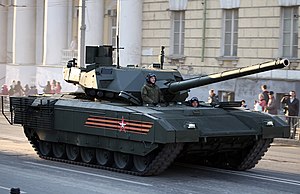T-14 Armata
| T-14 Armata | |
|---|---|

A Russian Army T-14 Armata tank.
|
|
| Type | Main battle tank |
| Place of origin | Russia |
| Service history | |
| Used by | Russian Ground Forces |
| Production history | |
| Designer | Ural Design Bureau of Transport Machine-Building, Uralvagonzavod |
| Manufacturer | Uralvagonzavod |
| Unit cost | T-14: $3.7 million |
| Produced | 2015–present |
| No. built | 20+ |
| Specifications | |
| Weight |
More than 50 t 49 t (with Urban Warfare Package) |
| Length | 10.8 m (35 ft) |
| Width | 3.5 m (11 ft) |
| Height | 3.3 m (10 ft) |
| Crew | 3 |
|
|
|
| Armor |
44S-sv-Sh 900 mm vs APFSDS and 1400 vs HEAT. Internal armored capsule with more than 900 mm RHA equivalentMalachit (4th generation ERA) can reduce penetration of APFSDS and HEAT rounds by at least 50% |
|
Main
armament |
125 mm (4.92 in) smoothbore 2A82-1M tank cannon with 45 rounds (32 of them in the autoloader) |
|
Secondary
armament |
12.7 mm (0.50 in) Kord machine gun (6P49), 7.62 mm (0.30 in) PKTM machine gun (6P7К) |
| Engine | diesel 1,500 hp–2,000 hp |
| Power/weight | 31hp/t |
| Transmission | 12-speed automatic gearbox |
|
Operational
range |
min 500 kilometres (310 mi) |
| Speed | 80 km/h (50 mph)–90 km/h (56 mph) (estimated) |
|
|
More than 50 t
44S-sv-Sh
The T-14 Armata (Russian: Т-14 «Армата»; industrial designation "Object 148") is a Russian main battle tank based on the Armata Universal Combat Platform. It is the first series-produced next generation tank. The Russian Army plans to acquire 2,300 T-14s in the period 2015–2020. The first batch of T-14 Armata tanks will be deployed to the Taman division after 2020, tanks will be transferred only after the completion of all state tests.
Featuring a number of innovative characteristics, the T-14 represents a new generation of Russian main battle tanks. The most significant new feature is the use of an unmanned turret, with the crew of three seated in an armored capsule in the front of the hull. The development of the tank took five years.
The main armament of the T-14 is the 2A82-1M 125 mm (4.92 in) smoothbore cannon, a replacement for the 2A46 of previous Russian and Soviet tanks. Its muzzle energy is greater than one of the world’s previously considered best cannons: the German Leopard 2 Rheinmetall 120 mm gun. The 125 mm gun has 15-20 percent improved accuracy and its rolling fire angular dispersion has improved 1.7 times. Features include an absence of a fume extractor (due to the unmanned turret), a firing rate of 10–12 rounds per minute, left side casing ejection port for the 125mm gun and a maximum effective-penetration range of 8 km with ATGMs. The detection range of the tank's optical sensors is more than 5 km for tank-sized targets in daylight, and at least 3.5 km at night through the thermal imaging channel. The gunner sight's optical channel is equipped with 4× and 12× optical zoom. The laser rangefinder has a theoretical maximum range of 7.5 km. These systems are duplicated; in addition there is a weaker third system that can fire on the move. The crew uses a high-definition camera with a 360-degree field.
...
Wikipedia
